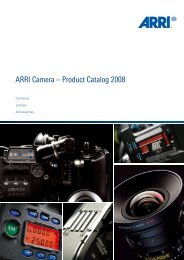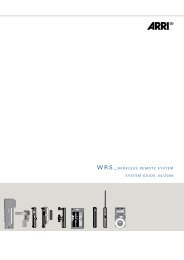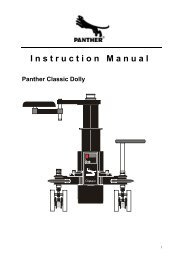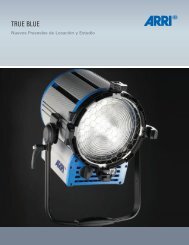ALEXA Studio Electronic and Mirror Shutter
ALEXA Studio Electronic and Mirror Shutter
ALEXA Studio Electronic and Mirror Shutter
You also want an ePaper? Increase the reach of your titles
YUMPU automatically turns print PDFs into web optimized ePapers that Google loves.
<strong>ALEXA</strong> <strong>Electronic</strong> <strong>Shutter</strong> Timing<br />
When the mirror shutter of the <strong>ALEXA</strong> <strong>Studio</strong> is turned off, exposure timing works just like it does with the<br />
<strong>ALEXA</strong>, <strong>ALEXA</strong> Plus <strong>and</strong> <strong>ALEXA</strong> M, using a rolling electronic shutter. In this case, nothing physically covers the<br />
sensor <strong>and</strong> light continuously falls onto the photosites <strong>and</strong> is continuously converted into an electrical charge.<br />
The diagram below shows the state of the <strong>ALEXA</strong> sensor in the top line of rectangles <strong>and</strong> a timeline below.<br />
1. At the beginning of each exposure the sensor resets all photosites to empty them of any charge.<br />
1a. Photosites are reset one after the other, starting with the top left photosite.<br />
1b. The reset process scans down line by line to the bottom right.<br />
2. During the exposure time the photosites then accumulate a charge based on how much light falls on them.<br />
The more light falls on each photosite, the higher the charge.<br />
3. Once the exposure time is over, the charge in each photosite is measured <strong>and</strong> read-out.<br />
3a. The read-out also occurs starting from top left.<br />
3b. The read-out scans down line by line to the bottom right.<br />
4. After the read-out the photosites still convert light into a charge, however, this is ignored until the next reset<br />
(go back to 1).<br />
Both reset <strong>and</strong> read-out happen not at the same time for all pixels, but in a scanning fashion from top left to<br />
bottom right. The duration of this scan determines how much of a rolling shutter artifact will be visible. The<br />
<strong>ALEXA</strong> sensor has a very fast reset <strong>and</strong> read-out, so while rolling shutter artifacts like skew <strong>and</strong> partially<br />
exposed frames are possible, they are greatly minimized.<br />
The only temporal limitation to this process is the time it takes to switch from read-out to reset. Since this time is<br />
very short for the <strong>ALEXA</strong> sensor it is possible to set electronic shutter angles from 5º up to 358º at all frame<br />
rates up to 60 fps <strong>and</strong> from 5º to 356º at frame rates from 60 to 120 fps.<br />
<strong>ALEXA</strong> <strong>Studio</strong> <strong>Electronic</strong> <strong>and</strong> <strong>Mirror</strong> <strong>Shutter</strong> White Paper Page 5 of 9











